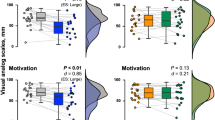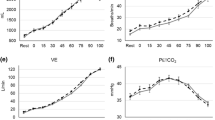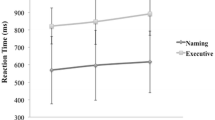Abstract
Purpose
This study tested the hypotheses that eccentric cycling (ECC) would be more cognitively demanding than concentric cycling (CONC), and attention and vigilance would improve more after ECC than CONC.
Methods
Thirty young adults performed CONC and two bouts of ECC (ECC1 and ECC2) for 20 min at a similar workload (227.5 ± 51.5 W) with 1-week apart. Cognitive load during exercise was assessed by the average error from the target torque over 1200 (60 rpm × 20 min) revolutions, choice reaction time (CRT), the NASA-task load index (NASA-TLX), and prefrontal cortex oxygenation and deoxygenation (HHb) by near-infrared spectroscopy. Attention and vigilance were assessed by a sustained attention to response task (SART) before, immediately, and at every 15 min for 60 min after exercise or sitting (control).
Results
Heart rate was lower during ECC1 (115.5 ± 20.3 bpm) and ECC2 (116.7 ± 21.0 bpm) than CONC (156.9 ± 19.4 bpm). The torque error was greater for ECC1 (26.1 ± 9.0%) and ECC2 (19.4 ± 9.0%) than CONC (10.8 ± 3.7%). CRT (CONC: 602.8 ± 69.0, ECC1: 711.1 ± 113.0, ECC2: 693.6 ± 122.6 ms) and mental demand in NASA-TLX (46.8 ± 25.8, 80.0 ± 15.3, 60.3 ± 17.6) were greater for ECC1 and ECC2 than CONC. Decreases in HHb were greater for ECC1 (− 0.41 ± 0.37 µM) and ECC2 (− 0.40 ± 0.40 µM) than CONC (0.10 ± 0.40 µM) and control (− 0.21 ± 0.28 µM). Attention and vigilance decreased 2–8% after 20-min sitting, but improved 2–10% immediately after ECC2, and did not decline from the baseline for 30 min after ECC1 or 60 min after CONC and ECC2.
Conclusion
Cognitive load was greater during ECC than CONC, but post-exercise attention and vigilance changes were not largely different between ECC and CONC.





Similar content being viewed by others
References
Abbott BC, Bigland B, Ritchie JM (1952) The physiological cost of negative work. J Physiol 117:380–390
Anderson-Hanley C, Arciero PJ, Brickman AM, Nimon JP, Okuma N, Westen SC, Merz ME, Pence BD, Woods JA, Kramer AF (2012) Exergaming and older adult cognition: a cluster randomized clinical trial. Am J Prev Med 42(2):109–119
Brisswalter J, Arcelin R, Audiffren M, Delignieres D (1997) Influence of physical exercise on simple reaction time: effect of physical fitness. Percept Mot Skills 85(3):1019–1027
Brisswalter J, Collardeau M, René A (2002) Effects of acute physical exercise characteristics on cognitive performance. Sports Med 32(9):555–566
Brünken R, Steinbacher S, Plass JL, Leutner D (2002) Assessment of cognitive load in multimedia learning using dual-task methodology. Exp Psychol 49(2):109–119
Budde H, Voelcker-Rehage C, Pietraßyk-Kendziorra S, Ribeiro P, Tidow G (2008) Acute coordinative exercise improves attentional performance in adolescents. Neurosci Lett 441(2):219–223
Cao A, Chintamani KK, Pandya AK, Ellis RD (2009) NASA TLX: software for assessing subjective mental workload. Behav Res Methods 41(1):113–117
Chang Y, Labban J, Gapin J, Etnier J (2012) The effects of acute exercise on cognitive performance: a meta-analysis. Brain Res 1453:87–101
Chang H, Kim K, Jung Y-J, Ahn N-R, So W-Y, Kato M (2013) Effects of blood flow to the prefrontal cortex on high-intensity exercise combined with high-decibel music. J Exerc Nutr Biochem 17(4):115–122
Davranche K, McMorris T (2009) Specific effects of acute moderate exercise on cognitive control. Brain Cogn 69(3):565–570
Delignières D, Brisswalter J, Legros P (1994) Influence of physical exercise on choice reaction time in sports experts: the mediating role of resource allocation. J Hum Mov Stud 27(4):173–188
DiDomenico A, Nussbaum MA (2011) Effects of different physical workload parameters on mental workload and performance. Int J Ind Ergon 41(3):255–260
Duchateau J, Baudry S (2014) Insights into the neural control of eccentric contractions. J Appl Physiol 116:1418–1425
Duncan A, Meek JH, Clemence M, Elwell CE, Tyszczuk L, Cope M, Deply DT (1995) Optical pathlength measurements on adult head, calf and forearm and the head of the newborn infant using phase resolved spectroscopy. Phys Med Biol 40(2):295–304
Faul F, Erdfelder E, Lang AG, Buchner A (2009) G*Power 3: a flexible statistical power analysis program for the social, behavioral, and biomedical sciences. Behav Res Methods 39:175–191
Giles GE, Brunyé TT, Eddy MD, Mahoney CR, Gagnon SA, Taylor HA, Kanarek RB (2014) Acute exercise increases oxygenated and deoxygenated hemoglobin in the prefrontal cortex. NeuroReport 25(16):1320–1325
Hart SG, Staveland LE (1988) Development of NASA-TLX (task load index): results of empirical and theoretical research. Adv Psychol 52:139–183
Hedges LV, Olkin I (1985) Statistical methods for meta-analysis. Academic Press, Orlando
Helton WS, Hollander TD, Warm JS, Matthews G, Dember WN, Wallaart M, Beauchamp G, Parasuraman R, Hancock PA (2005) Signal regularity and the mindlessness model of vigilance. Br J Psychol 96(2):249–261
Hillman CH, Erickson KI, Kramer AF (2008) Be smart, exercise your heart: exercise effects on brain and cognition. Nat Rev Neurosci 9(1):58–65
Hogan CL, Mata J, Carstensen LL (2013) Exercise holds immediate benefits for affect and cognition in younger and older adults. Psychol Aging 28(2):587–594
Hoppeler H (2014) Eccentric Exercise: physiology and application in sport and rehabilitation, vol 8. Routledge
Jackson SA, Kleitman S, Aidman E (2014) Low cognitive load and reduced arousal impede practice effects on executive functioning, metacognitive confidence and decision making. PLoS One 9(12):e115689
Kashihara K, Nakahara Y (2005) Short-term effect of physical exercise at lactate threshold on choice reaction time. Percept Mot Skills 100(2):275–291
Kikukawa A, Kobayashi A, Miyamoto Y (2008) Monitoring of pre-frontal oxygen status in helicopter pilots using near-infrared spectrophotometers. Dyn Med 7(1):10
Lambourne K, Tomporowski P (2010) The effect of exercise-induced arousal on cognitive task performance: a meta-regression analysis. Brain Res 1341:12–24
Lennemann LM, Sidrow KM, Johnson EM, Harrison CR, Vojta CN, Walker TB (2013) The Influence of agility training on physiological and cognitive performance. J Strength Cond Res 27(12):3300–3309
Ludyga S, Gerber M, Brand S, Holsboer-Trachsler E, Pühse U (2016) Acute effects of moderate aerobic exercise on specific aspects of executive function in different age and fitness groups: a meta-analysis. Psychophysiol 53(11):1611–1626
McMorris T, Myers S, MacGILLIVARY WW, Sexsmith JR, Fallowfield J, Graydon J, Forster D (1999) Exercise, plasma catecholamine concentrations and decision-making performance of soccer players on a soccer-specific test. J Sport Sci 17(8):667–676
Mueller M, Breil FA, Vogt M, Steiner R, Lippuner K, Popp A, Klossner S, Hoppeler H, Däpp C (2009) Different response to eccentric and concentric training in older men and women. Eur J Appl Physiol 107(2):145–153
Nosaka K, Haynes A, Chasland LC, Maiorana A, Naylor LH, Green DJ (2017) Reply to Drs. Pageaux et al.: cognitive demand of eccentric versus concentric cycling. J Appl Physiol 123(5):1418
Peñailillo L, Blazevich A, Numazawa H, Nosaka K (2013) Metabolic and muscle damage profiles of concentric versus repeated eccentric cycling. Med Sci Sports Exerc 45(9):1773–1781
Rinnan Å, van den Berg F, Engelsen SB (2009) Review of the most common pre-processing techniques for near-infrared spectra. TrAC-Trend Anal Chem 28(10):1201–1222
Robertson IH, Manly T, Andrade J, Baddeley BT, Yiend J (1997) Oops!’: performance correlates of everyday attentional failures in traumatic brain injured and normal subjects. Neuropsychologia 35(6):747–758
Rooks CR, Thom NJ, McCully KK, Dishman RK (2010) Effects of incremental exercise on cerebral oxygenation measured by near-infrared spectroscopy: a systematic review. Prog Neurobiol 92(2):134–150
Schmidt-Kassow M, Zink N, Mock J, Thiel C, Vogt L, Abel C, Kaiser J (2014) Treadmill walking during vocabulary encoding improves verbal long-term memory. Behav Brain Func 10(1):24
Sibley BA, Etnier JL, Le Masurier GC (2006) Effects of an acute bout of exercise on cognitive aspects of Stroop performance. J Sport Exerc Psychol 28(3):285–299
Smilek D, Carriere JS, Cheyne JA (2010) Failures of sustained attention in life, lab, and brain: ecological validity of the SART. Neuropsychologia 48(9):2564–2570
Smit AS, Eling PA, Hopman MT, Coenen AM (2005) Mental and physical effort affect vigilance differently. Int J Psychophysiol 57(3):211–217
Tomporowski PD (2003) Effects of acute bouts of exercise on cognition. Acta Physiol (Oxf) 112(3):297–324
Tomporowski PD, Ganio MS (2006) Short-term effects of aerobic exercise on executive processing, memory, and emotional reactivity. Int J Sport Exer Psychol 4(1):57–72
Voss MW, Nagamatsu LS, Liu-Ambrose T, Kramer AF (2011) Exercise, brain, and cognition across the life span. J Appl Physiol 111(5):1505–1513
Walker T, Lennemann L, Harrison C, Klien R, Doczy E (2011) The Influence of Agility Training on Physiological and Cognitive Performance. Air Force Research Lab Brooks AFB, TX
Xie B, Salvendy G (2000) Prediction of mental workload in single and multiple tasks environments. Int J Cogn Ergonomics 4(3):213–242
Young MS, Robinson S, Alberts P (2009) Students pay attention! Combating the vigilance decrement to improve learning during lectures. Active Learning in Higher Education 10(1):41–55
Zimmermann P, Sprengelmeyer R, Fimm B, Wallesch C-W (1992) Cognitive slowing in decision tasks in early and advanced Parkinson’s disease. Brain Cogn 18(1):60–69
Acknowledgements
This study was supported by an International Postgraduate Research Scholarship at Edith Cowan University that was awarded to the author. Authors thank all participants who volunteered for this study. There is no conflict of interest.
Author information
Authors and Affiliations
Contributions
Kan: designed the study, collected and analysed the data, wrote up the manuscript draft. Speelman: designed the study, checked the final draft of the manuscript. Nosaka: designed the study, analysed the data, checked final draft of the manuscript.
Corresponding author
Ethics declarations
Conflict of interest
The authors declare that they have no conflict of interest.
Additional information
Communicated by Toshio Moritani.
Publisher's Note
Springer Nature remains neutral with regard to jurisdictional claims in published maps and institutional affiliations.
Rights and permissions
About this article
Cite this article
Kan, B., Speelman, C. & Nosaka, K. Cognitive demand of eccentric versus concentric cycling and its effects on post-exercise attention and vigilance. Eur J Appl Physiol 119, 1599–1610 (2019). https://doi.org/10.1007/s00421-019-04149-y
Received:
Accepted:
Published:
Issue Date:
DOI: https://doi.org/10.1007/s00421-019-04149-y




